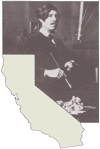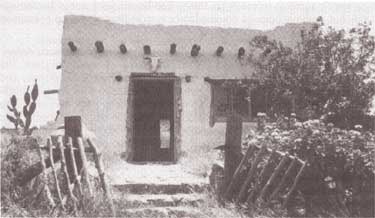![]()

Five Views: An Ethnic Historic Site Survey for California
MENU
Introduction
Mexican War
![]() Post-Conquest
Post-Conquest
1900-1940
World War II
Chicano Movement
Future
Historic Sites
Selected References

A History of Mexican Americans in California:
POST-CONQUEST CALIFORNIA
No sooner had the treaty been signed than the first major post-war influx of Anglos began, fueled by the discovery of gold in 1848. The 10,000 Californios (pre-conquest Mexican Californians) soon found the territory swamped by Anglo-American migrants and foreign immigrants. The latter included Chileans, Peruvians, Basques, and Mexicans, particularly miners from the Mexican province of Sonora. However, despite this Latino immigration, the Spanish-speaking population of California fell to 15 percent by 1850, and to four percent by 1870.
Northern California received the major thrust of the Anglo gold rush migration, while southern California remained heavily Mexican. This ethnic contrast was one factor in the debate over the possibility of dividing California into two states, as happened in the case of New Mexico and Arizona. However, the coming of the transcontinental railroad to southern California in the 1870s spurred a land boom and the state's second major population explosion. By the 1880s, Anglo settlers were also numerically dominant in the southern part of the state.
The presence of a Mexican majority in 1848 contributed to a promising start for good ethnic relations in California. Californios participated widely in the early post-conquest government, and provided eight of the 48 delegates to the 1849 state constitutional convention. There they won such transitory victories as a provision that all state laws and regulations be translated into Spanish. In southern California, where Californios remained a majority in some places until the 1880s, they continued to be elected to local and county positions, and a handful held state offices or seats in the legislature.
However, the rapid establishment of a heavy statewide Anglo majority quickly rendered Mexican Americans politically powerless at the state level. As a result, they could not prevent enactment of inequitable and sometimes discriminatory laws. For example, the legislature placed the heaviest tax burden on land, an abrupt and decimating shift from the Mexican system of taxing production rather than land. Although this tax also hurt Anglo landowners, it seriously undermined the Californio economic position, based primarily on ranching. The Foreign Miners' Tax of 1850, a $20 monthly fee for the right to mine, was applied not only to foreign immigrants but also to California-born Mexicans, who had automatically be come U.S. citizens under the terms of the Treaty of Guadalupe Hidalgo. The state anti-vagrancy act of 1855 was so obviously anti-Mexican that it became known popularly as the Greaser Law. Possibly the most blatantly anti-Mexican law was the 1855 act negating the constitutional requirement that laws be translated into Spanish. Finally, there were growing vigilantism and squatter violence against Californio landowners.
Land had been the basis of the California socio-economic system. The loss of land after the U.S. conquest undermined that system, in spite of the theoretical protections provided by the Treaty of Guadalupe Hidalgo. Holders of Spanish and Mexican land grants, most of whom were Mexican Americans, had to seek legal confirmation of their titles. In effect, the federal government placed the burden of proof on the landowners instead of automatically accepting all titles and then handling challenges on an individual basis.
Already suffering from heavy taxes and lacking capital, Chicano landowners had to go through the slow, expensive process of legally confirming their claims, and often were forced to borrow money at high interest rates to cover the costs of the legal struggle. Moreover, they had to argue their cases before U.S. judges and land commissioners unfamiliar with Hispanic legal principles and the land tenure system on which land grants were based. Even when they did win confirmation of their grants, Mexican Americans often found themselves personally destitute, or had to sacrifice their land to pay their legal expenses.
To adjudicate landholdings in California, Congress passed the Land Act of 1851, establishing a Board of Land Commissioners to review claims. If appealed, cases moved on to the U.S. district court, and even the Supreme Court. Of the 813 claims, 549 were appealed (417 by government attorneys), some as many as six times. The board went out of business in 1856, but multiple appeals caused land cases to drag on for an average of 17 years.
Loss of land contributed heavily to relegation of Mexican Americans to the lower echelons of the California socio-economic system. The loss eroded their economic base, undermined their political power, and displaced ranchworkers. Some Chicanos managed to find work in traditional occupations, such as vaquero or sheepshearer, but often only on a part-time basis. Most displaced Chicanos became laborers, poorly paid and often migratory, in expanding large-scale commercial agriculture. Others moved to cities, where their pastoral and agricultural skills were of little use. Many found employment in railroads, construction, and food processing.
Increasingly incorporated into the labor market in the nineteenth century as unskilled or semi-skilled manual laborers, Chicanos experienced job displacement, and in some areas, actual downward occupational mobility. Anglo hostility and low levels of education limited their access to jobs in the rapidly expanding white-collar sector, and Chicanos also encountered obstacles to upward mobility even in occupations in which they had considerable skill and experience. In Los Angeles, for example, Chicanos disappeared completely from the ranks of hatmakers, masons, and tailors. Despite long pastoral experience, Chicanos found employment on ranches only as ranchhands, while Anglos held most supervisory positions.
Another aspect of the nineteenth century economic shift was the entry of Mexican American women into the labor market. As Mexican American men found themselves more occupationally disadvantaged, women became increasingly employed as domestics, laundresses, farm laborers, and cannery and packinghouse workers. A rise in the proportion of female-headed households reflected these socio-economic stresses.
Concomitant with the Chicano economic decline was emergence of residential and social segregation. Chicano barrios and colonias consisted of various types. Some traditional Mexican towns became transformed into barrios as Anglos immigrated and established their own segregated neighborhoods, or as newly established Anglo cities expanded until they enveloped historic Mexican communities. Displaced Chicanos and immigrating Mexicans often established new barrios and colonias.
Barrios and colonias developed and survived through a combination of force and choice. In Anglo areas, anti-Mexican segregation, often embedded in restrictive covenants on real estate, slammed the residential door on the vast majority of Mexican Americans, the major exceptions being Chicanos with wealth, social status, light skins, and presumed Spanish identity. On the other hand, most Chicanos and new Mexican immigrants probably preferred living among people who shared their heritage, culture, and language. The little intermarriage that took place almost always involved Anglo men and daughters from wealthy "Spanish" families — events that often accompanied business partnerships or political alliances.
In Chicano areas, traditional extended family and community social life flourished. There were bullfights, rodeos, horse races, and various fiestas, including the celebration of Mexican Independence Day (September 16) and Cinco de Mayo (May 5 — the 1862 Mexican victory over the French at Puebla). The Catholic Church often provided a focus for social as well as religious life. Mexican American political, cultural, patriotic, and mutual aid organizations began to develop, but remained generally local in focus. Chicano newspapers strengthened community cohesion and spoke out against injustices, but they were undercapitalized, and were forced to engage in a constant, ultimately losing struggle for survival.
Faced with a pervasive pattern of economic dislocation, declining political influence, violence, and discrimination, Chicanos fought back.
Usually, they maneuvered within the system — through the courts, political channels, and newspapers — but at times they resorted to force to defend their rights. Some Chicanos, such as Tiburcio Vasquez, turned to banditry for survival and as a means of expressing grievances and frustrations with Anglo treatment. Nonetheless, by the end of the nineteenth century, Chicanos had declined from an influential majority to a relatively powerless minority.

Leo Carillo Ranch, San Diego County
NEXT> 1900-1940
Last Modified: Wed, Nov 17 2004 10:00:00 pm PDT
http://www.cr.nps.gov/history/online_books/5views/5views5b.htm
![]()
 Top
Top